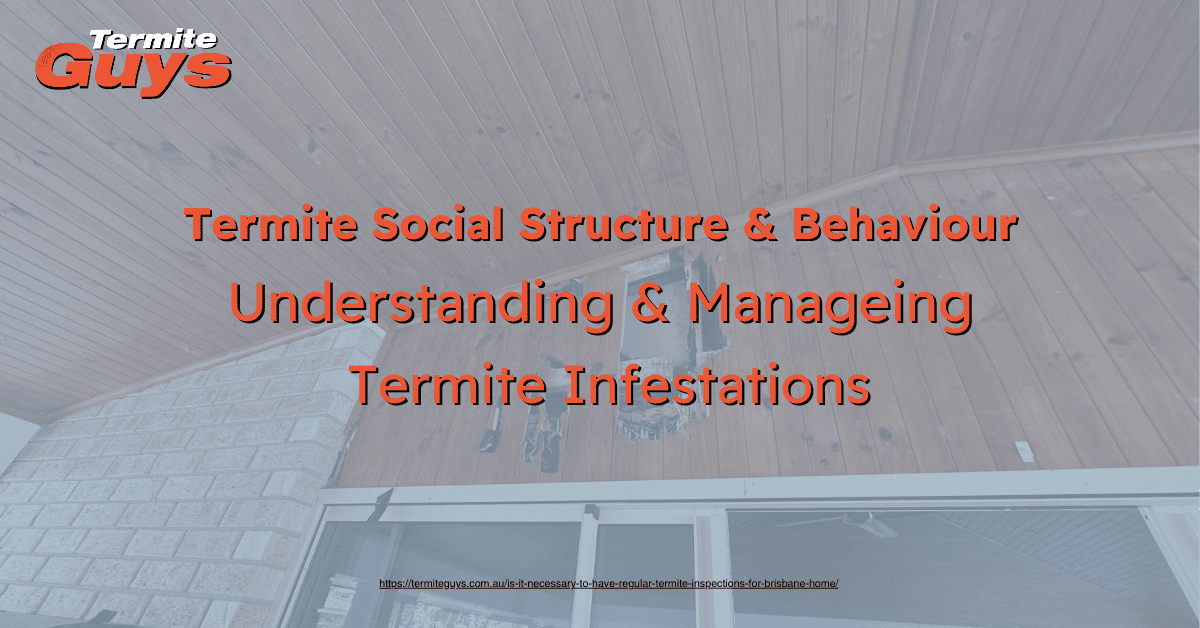Termites are more than just pests; they are complex social insects that live in highly organized colonies. Understanding the social structure and behavior of termite colonies, especially the role of the queen, is crucial for effective termite management. This guide delves into the intricate dynamics of termite societies and offers insights into managing and preventing termite infestations, with a focus on strategies applicable to Brisbane homeowners and pest control professionals. Call Termite Guys on : 07-3393-3515
The Role of the Queen and Reproductive Dynamics Within the Colony
At the heart of every termite colony is the queen. Her primary role is reproduction, laying thousands of eggs daily to ensure the colony’s growth and survival. In some species, a queen can live for up to 25 years. She is attended by a group of worker termites who groom, feed, and protect her. The queen’s reproductive output allows the colony to expand rapidly, making early detection of termite activity critical for preventing extensive damage.
Besides the queen, termite colonies may also contain a king, who aids in reproduction, and secondary reproductive individuals. These secondary reproductives can take over the queen’s role if she dies, ensuring the colony’s continued growth. This reproductive hierarchy within the termite colony underscores the challenge of termite eradication—targeting the queen and the reproductive system is vital for effective control.
Overview of the Termite Social Structure
Workers: The most numerous caste in the colony, worker termites perform a variety of essential tasks, including foraging for food, feeding other colony members, building and maintaining tunnels and nests, and caring for the queen’s eggs. Workers are responsible for the damage caused to wooden structures as they feed on cellulose.
Soldiers: Soldiers have a primary role in defending the colony against predators, such as ants. They have powerful jaws or chemical-spraying abilities and rely on workers to feed them since they cannot feed themselves.
Nymphs: Nymphs are immature termites that have the potential to develop into other castes, such as workers, soldiers, or reproductive individuals, depending on the colony’s needs. Their presence ensures the colony’s adaptability and ability to recover from losses.
Alates (Swarmers): These are winged reproductive termites that leave the colony to establish new colonies. The swarming process is a key indicator of termite presence and a sign that a nearby colony is mature and active.
Behavioral Patterns and Communication Methods
Termites exhibit highly coordinated behavior, often attributed to their efficient communication methods. They use chemical signals (pheromones) to communicate, leaving scent trails for navigation and marking food sources. Vibrations and physical contact also play roles in communication within the dark, enclosed environments they inhabit.
Understanding these behavioral patterns is crucial for effective termite management. For example, the creation of mud tubes by termites not only aids their movement but also signals an infestation. Detecting these tubes early can prevent the colony from spreading further into the property.
Precautionary Methods for Termite Prevention and Eradication
Preventing termite infestations requires a multifaceted approach:
Physical Barriers: In new constructions, incorporating physical barriers like stainless steel mesh or graded stone can prevent termites from entering structures.
Chemical Treated Zones (Termite Barriers): Chemical treatments, such as Termidor, can create treated zones around the property, acting as a barrier that termites cannot detect. As they pass through these zones, they carry the treatment back to the colony, eventually eliminating it. This strategy is highly effective and is recommended for both prevention and eradication of termites.
Moisture Control: Since termites are attracted to moisture, homeowners should ensure proper drainage around the property, fix leaks promptly, and reduce humidity levels in crawl spaces and basements.
Regular Inspections: Routine termite inspections by licensed professionals are vital, especially in termite-prone areas like Brisbane. Inspections can identify early signs of infestation, such as mud tubes, discarded wings, and hollow-sounding wood, allowing for timely intervention.
Best Practices for Monitoring and Managing Termite Activity
Annual Inspections: The Australian standards recommend that all properties be inspected annually. These inspections should include thermal imaging and moisture meters to detect hidden termite activity.
Use of Professional Services: Engaging a licensed termite management company is essential. Professionals like Termite Guys Brisbane offer comprehensive inspections and tailored treatments using cutting-edge equipment like Termatrac motion detectors and thermal imaging cameras.
Chemical Treatments: For established infestations, targeted treatments such as Termidor foam can eradicate the colony, including the queen. Follow-up treatments and preventive barriers ensure long-term protection.
Baiting Systems: In some cases, termite baiting systems can be used to eliminate termites. Baits containing slow-acting insecticides are placed around the property. Termites consume the bait and carry it back to the colony, effectively wiping it out over time.
Concluding Thoughts
Understanding the social structure and behavior of termites is key to effective management and prevention. The queen’s role in reproduction and the colony’s complex hierarchy make termites formidable pests. However, with professional inspection services and targeted treatments, homeowners and property managers can protect their properties from termite damage.
Call to Action: If you suspect termite activity or want to safeguard your property, contact the Termite Guys Brisbane for a comprehensive assessment. Our experienced team uses state-of-the-art equipment and proven treatments to protect your home. Reach out today to ensure your property remains termite-free.


